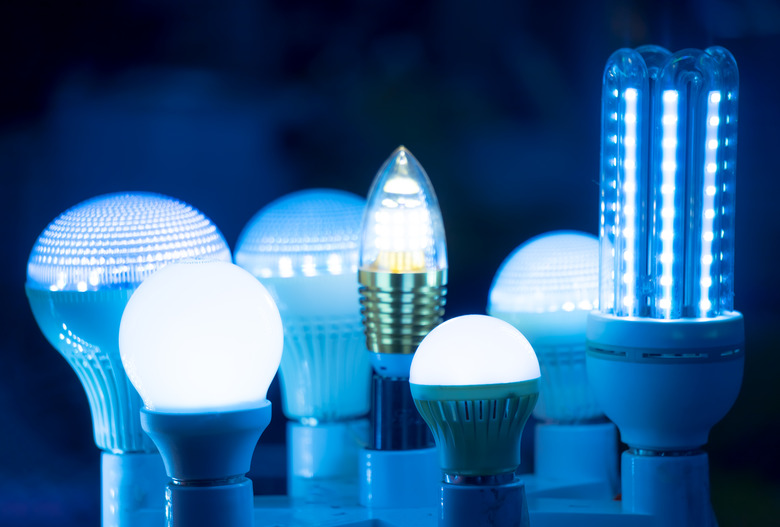Frequency Of LED Lights
Light emitting diodes are electrical components used in a variety of applications to create light, or electromagnetic radiation, by a process known as electroluminescence. The LED's color depends on its frequency within the electromagnetic spectrum. Today you can find LEDs in a wide variety of colors, corresponding to a range of frequencies they operate at.
TL;DR (Too Long; Didn't Read)
The electromagnetic frequencies of light emitting diodes range from under 400 terahertz to over 600 terahertz, corresponding to red and blue light, respectively.
Red LED Devices
Red LED Devices
Red LED devices produce light at a wavelength of approximately 633 nanometers (nm). The following equation is useful to find the frequency of a LED device:
\(\text{frequency}=\frac{\text{speed of light}}{\text{wavelength}}=\frac{3\times10^8\text{ m/s}}{633\times10^{-9}\text{ m}}\)
Carrying out this calculation leads to a frequency of 474 terahertz (THz), which places it in the red region of the visible electromagnetic spectrum. At the University of Illinois, Professor Nick Holonyak developed the first practical red LED devices in 1962. Red LEDs use the material indium gallium aluminum phosphide and find many uses in electronic displays, indicator lights and other applications.
Blue LED Devices
Blue LED Devices
Former Nichia scientist Shuji Nakamura invented Blue LED devices in 1993. These devices operate at a wavelength of approximately 470 nm, therefore:
\(\text{frequency}=\frac{\text{speed of light}}{\text{wavelength}}=\frac{3\times10^8\text{ m/s}}{490\times10^{-9}\text{ m}}\)
Completing the calculation leads to a frequency of approximately 638 THz. Modern blue LEDs are based upon the materials silicon carbide and gallium nitride, and are now cheap enough to be used in everyday electrical appliances.
Green LED Devices
Green LED Devices
In 2010, research scientists working at the National Renewable Energy Laboratory developed the first green LEDs. These devices operate at a wavelength of approximately 560 nm and there have a frequency:
\(\text{frequency}=\frac{\text{speed of light}}{\text{wavelength}}=\frac{3\times10^8\text{ m/s}}{560\times10^{-9}\text{ m}}\)
Carrying out this calculation leads to a frequency of 535 THz. The final invention of green LED devices paved the way for the creation of white LED light sources.
White LED Devices
White LED Devices
White light consists of individual red, blue and green components, so it doesn't have a single wavelength or frequency. White LED devices have a mixture of the frequencies 474 THz, 535 THz and 638 THz. The development of white LED devices has led to cheap, energy-efficient lighting that can be used in a variety of settings, from street lamps to desk lights.
References
- Geogia State University: Light Sources in Electronics
- OKSolar.com: Technical LED's LED Color Chart
- Geogia State University: Visible Light
- Massachusetts Institute of Technology: LED Inventor, Materials Scientist Win 2004 Lemelson-MIT Prizes
- New Scientist: Firm Sees Red Over Blue LED Invention Claims
- Phys.org: NREL Finds a Way to Give LEDs the Green Light
Cite This Article
MLA
Markings, Samuel. "Frequency Of LED Lights" sciencing.com, https://www.sciencing.com/frequency-led-lights-9592/. 2 November 2020.
APA
Markings, Samuel. (2020, November 2). Frequency Of LED Lights. sciencing.com. Retrieved from https://www.sciencing.com/frequency-led-lights-9592/
Chicago
Markings, Samuel. Frequency Of LED Lights last modified March 24, 2022. https://www.sciencing.com/frequency-led-lights-9592/
